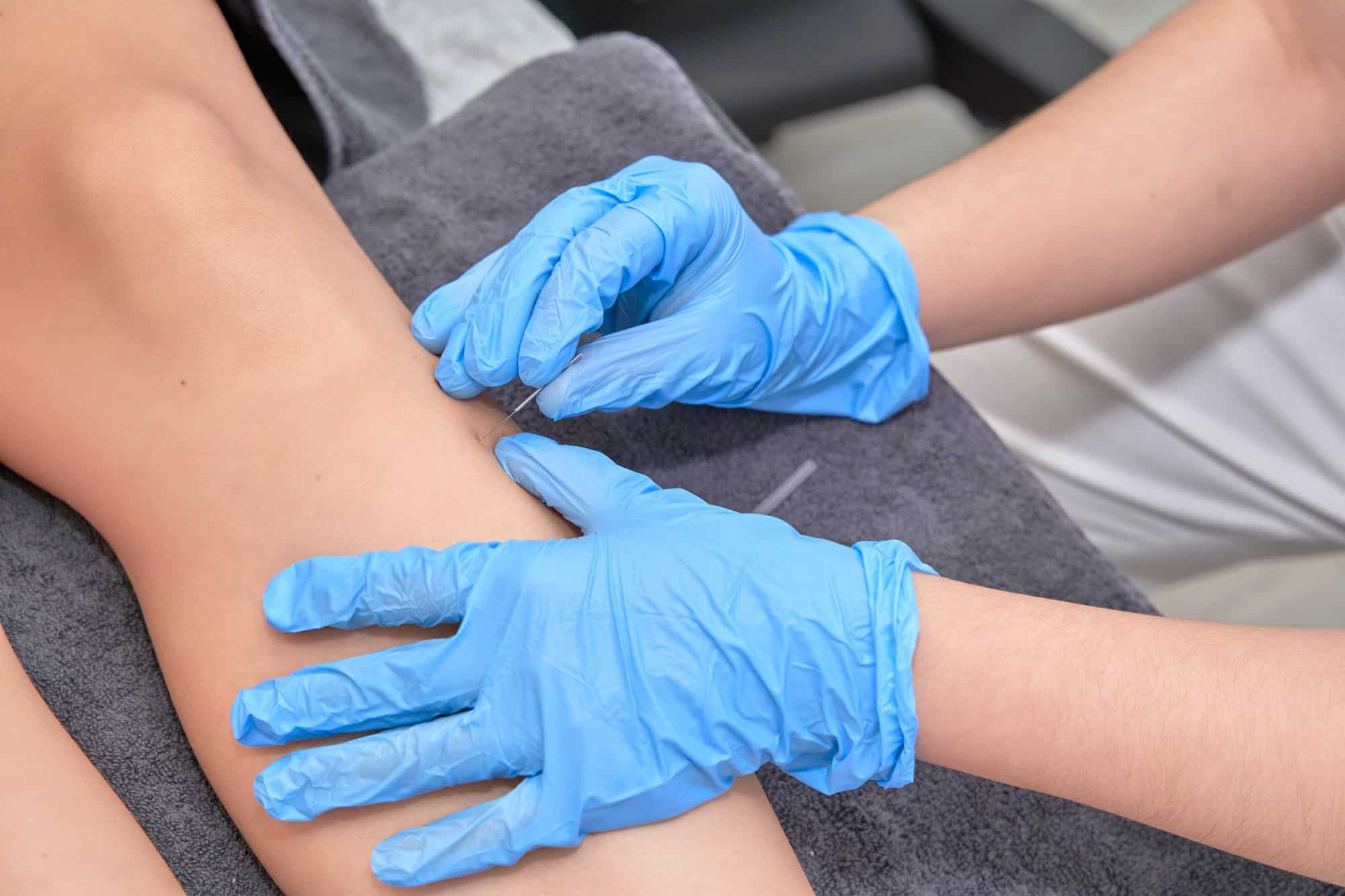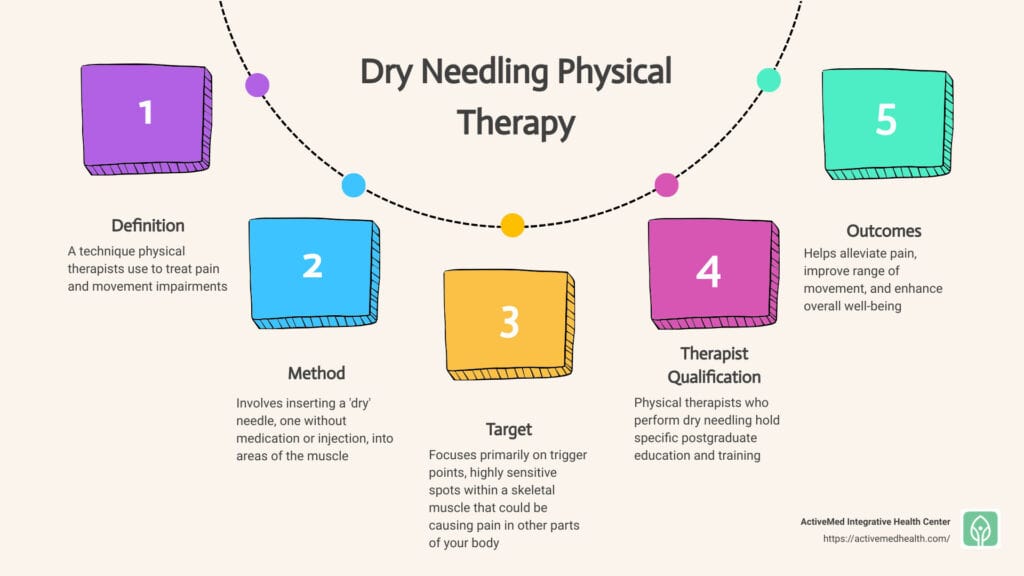Do you constantly struggle with stubborn muscular knots or ongoing pain that usual treatments never seem to fully alleviate? One strategy, offering natural, non-surgical relief, is gaining considerable attention in the field of physical therapy. Known as dry needling, this technique presents potent potential to not only relieve pain but also improve a patient’s range of motion. At ActiveMed Integrative Health Center, we often employ dry needling as part of our larger treatment plan to offer comprehensive care to our patients. And even though dry needling might sound a bit intimidating, it’s essential to understand that it’s a safe, scientifically backed procedure designed to help you on your path to recovery.
Dry needling is a modern Western medicine technique that involves inserting a thin, sterile needle into muscle trigger points. This method is not to be confused with acupuncture, a traditional Chinese medicine discipline. Though both practices involve needles, they differ significantly in philosophy and execution.
Essential Facts about Dry Needling Physical Therapy
- Definition: It’s a technique physical therapists use to treat pain and movement impairments.
- Method: It involves inserting a “dry” needle, one without medication or injection, into areas of the muscle.
- Target: Dry needling focuses primarily on trigger points, these are highly sensitive spots within a skeletal muscle that could be causing pain in other parts of your body.
- Therapist Qualification: Physical therapists who perform dry needling hold specific postgraduate education and training.
Understanding the Basics of Dry Needling
Understanding the basics of dry needling physical therapy can help you make informed decisions about your health care. This technique, used by physical therapists, is a part of modern Western medicine and has been supported by extensive research.
What is Dry Needling?
Dry needling is a technique that physical therapists use to treat pain and movement impairments. The “dry” in dry needling refers to the fact that the needle used doesn’t contain any medication. The needle is inserted into specific areas of the muscle, known as trigger points. Other names for dry needling include trigger point dry needling and intramuscular manual therapy.
Dry needling is not acupuncture. Though both techniques involve the use of needles, they are based on different principles. Acupuncture is based on traditional Chinese medicine performed by acupuncturists. Dry needling, on the other hand, is a part of modern Western medicine.
How Does Dry Needling Work?
Dry needling works by targeting trigger points in your muscles. These points are taut bands of skeletal muscle within a larger muscle group and can be tender to the touch. When these trigger points are stimulated by the needle, it helps to release or inactivate them, providing relief from pain and improving range of motion.
The dry needle used is a thin filiform needle that penetrates the skin and stimulates underlying myofascial trigger points and muscular and connective tissues. This allows the physical therapist to target tissues that they are not able to reach with their hands.
The Role of Trigger Points in Dry Needling
The role of trigger points in dry needling is crucial. These points are specific areas of a muscle that can cause pain and discomfort when compressed. Touching a trigger point can also refer pain to other parts of the body.
In the context of dry needling, a needle is inserted into these trigger points to stimulate them, causing a release or inactivation of the trigger point. This can lead to relief from pain or an improvement in the range of motion.
At ActiveMed Integrative Health Center, we employ qualified practitioners who have undergone extensive training in dry needling. Our team uses this technique as part of a larger treatment plan, tailored to each individual patient’s needs. This approach helps speed up the patient’s return to active rehabilitation.
The Benefits of Dry Needling in Physical Therapy
Dry needling therapy offers numerous benefits, especially when integrated into a comprehensive physical therapy treatment plan. These benefits include pain relief, improved range of motion, and enhanced healing.

Pain Relief and Improved Range of Motion
One of the primary benefits of dry needling is pain relief. By stimulating neural pathways and releasing endorphins, dry needling can disrupt pain signals and provide substantial relief from discomfort. The needles used in this therapy work by targeting specific trigger points in the body, releasing tension, and reducing muscle tightness. This process can significantly alleviate localized discomfort, leading to more effective pain management.
Additionally, dry needling can also improve range of motion. By relieving muscle tension and spasms, dry needling therapy enhances flexibility and allows for an increased range of motion. This improvement can transform patient’s abilities to perform daily tasks, engage in physical activities, and overall, lead a more active lifestyle.
Complementing Other Treatment Plans
Another significant benefit of dry needling is that it can complement other treatment methods. Whether it’s traditional therapies like chiropractic care or other physical therapy techniques, dry needling can enhance their effectiveness. By targeting specific pain points and improving mobility, dry needling can make these treatments more efficient and targeted, providing a more comprehensive approach to pain relief.
At ActiveMed Integrative Health Center, we believe in a holistic approach to healthcare. As such, we often combine dry needling with other treatment modalities to provide the most effective care for our patients.
Promoting Healing and Reducing Inflammation
Dry needling also promotes healing and reduces inflammation. The needles used in this therapy stimulate blood circulation to the affected areas, bringing oxygen, nutrients, and immune cells to the location. This increase in blood flow promotes tissue healing, reduces inflammation, and aids in muscle recovery.
Furthermore, dry needling can have long-term benefits. By addressing muscular dysfunction and breaking pain cycles, it promotes improved muscle function and can offer lasting relief for chronic pain conditions.
In conclusion, dry needling offers multiple benefits as a physical therapy technique. Whether it’s pain relief, improved mobility, or enhanced healing, dry needling can significantly contribute to a patient’s recovery and well-being. At ActiveMed Integrative Health Center, we’re committed to providing our patients with the best care, integrating dry needling into our comprehensive treatment plans where necessary.
Dry Needling vs Acupuncture: Key Differences
When it comes to alternative therapies, dry needling and acupuncture often come to mind. Many people are familiar with the concept of acupuncture, but dry needling is a relatively new and misunderstood concept. Here, we delve into the key differences between the two treatments.
Origins and Philosophies
Acupuncture has its roots in traditional Chinese medicine and has been practiced for over 3,000 years. It focuses on balancing the flow of energy or life force — known as chi or qi — through pathways in your body called meridians. By inserting needles into specific points along these pathways, acupuncturists aim to rebalance your energy and promote healing. Acupuncture treats a wide range of conditions, including pain, fatigue, infertility, headache, insomnia, anxiety, and depression.
On the other hand, dry needling, offered as part of our physical therapy services, is a Western medicine technique that has evolved over the last few decades. Its primary focus is on treating musculoskeletal and neuromuscular pain by releasing trigger points. Unlike acupuncture, which aims to restore energy flow, dry needling targets dysfunctional muscle trigger points.
Techniques and Tools Used
Both dry needling and acupuncture use thin, monofilament needles. However, the way these needles are used differs significantly. In acupuncture, needles are inserted at various depths to treat symptoms. After placement, the health care professional may gently move or manipulate the needles to stimulate the energy flow.
In contrast, during a dry needling treatment, the needles are inserted directly into trigger points, which are bands of tight, irritable muscle tissue. The needles remain in your muscle for a short period of time — between 10 seconds and 20 minutes — during treatment. This time frame depends on the treatment location, number of needles used, and treatment goals.
Number of Needles and Target Points
In a typical acupuncture session, multiple needles are used. These needles are inserted into specific points along the body’s energy pathways or meridians.
When it comes to dry needling, the number of needles used varies depending on the patient’s condition and the number of trigger points that need to be addressed. The needles used in dry needling are usually left in place for a shorter duration than in acupuncture.
In conclusion, while there are similarities between the dry needling physical therapy and acupuncture, the two treatments are fundamentally different in their origins, philosophies, techniques, and target points. Both treatments have their unique benefits, and at ActiveMed Integrative Health Center, we are experienced in both and can advise which treatment may be more suitable for your specific needs.
Practical Aspects of Dry Needling Physical Therapy
Now that we’ve covered the basic theory and benefits of dry needling physical therapy, let’s delve into the practical aspects. This includes who performs the procedure, what to expect during a session, and how long it takes to see results.
Who Performs Dry Needling?
At ActiveMed Integrative Health Center, our dry needling procedures are always performed by certified healthcare professionals. These are often qualified physical therapists, chiropractors, or medical doctors who have undergone proper training in dry needling. This ensures that the procedure is safe and yields optimal results.
What to Expect During a Dry Needling Session
During a dry needling session, you can expect the physical therapist to insert a “dry” needle, one without medication or injection, into areas of the muscle known as trigger points. These are taut bands of skeletal muscle within a larger muscle group, which can be tender to the touch. The needle stimulates underlying myofascial trigger points and muscular and connective tissues, which the therapist cannot reach with their hands.
While dry needling can cause mild bruising or soreness at the needle insertion sites, these usually subside within days. If discomfort arises, it is crucial to communicate this to the healthcare professional during the treatment session. Post-session, it is advised to avoid overworking yourself, using cold treatments for the soreness, and drinking alcohol.
How Long Does it Take for Dry Needling to Work?
Everyone’s body responds differently to dry needling. However, many patients notice improved mobility immediately after the session and decreased pain within 24 hours. For a lasting positive effect, typically a few treatment sessions (once a week for 2-3 weeks) are needed.
Dry needling is not a quick fix but a part of a comprehensive treatment plan that addresses the root cause of the issue. At ActiveMed Integrative Health Center, we integrate dry needling with other treatments for a holistic approach to back pain management, leading to better pain relief, increased mobility, and improved functional outcomes.
Next, we’ll discuss potential risks and disadvantages of dry needling.
Potential Risks and Disadvantages of Dry Needling
Just as with any medical treatment, dry needling physical therapy comes with potential risks and disadvantages that should be considered.
Possible Side Effects: Bruising and Swelling
Even though dry needling is generally safe, some individuals may experience side effects. Most commonly, patients may feel muscle soreness in the treated areas immediately after the procedure, which typically subsides within a day or two.
Minor bruising at the needle insertion sites can also occur but is usually mild and temporary. Some patients may experience temporary fatigue after a session, likely due to the release of endorphins and muscle relaxation.
In very rare instances, a needle may inadvertently puncture underlying structures such as blood vessels or nerves, which could lead to complications. These risks are significantly minimized when you’re working with a qualified and experienced practitioner.
What Not to Do After a Dry Needling Session
After your dry needling session, there are certain things you should avoid doing to maximize the treatment’s effectiveness and minimize discomfort. It’s common to feel a little sore after the treatment or notice some light bruising. You should not use cold treatments for this soreness, as they could potentially slow down the healing process.
Overworking yourself after a dry needling session is also not recommended. It’s vital to give your body time to heal and adjust to the treatment. Finally, avoid consuming alcohol after the treatment, as it could potentially interfere with the healing process.
At ActiveMed Integrative Health Center, we ensure that our patients are fully informed about the dos and don’ts after a dry needling session. We believe that a well-informed patient is more likely to have a successful recovery and treatment experience.
While dry needling has its potential risks and disadvantages, when performed by a trained professional, it’s a safe and effective treatment for many muscle-related issues. Understanding these aspects helps you make an informed decision about including dry needling in your treatment plan.
Dry Needling at ActiveMed Integrative Health Center
Now that we’ve explored what dry needling physical therapy is and how it can benefit you, it’s time to talk about our unique approach at ActiveMed Integrative Health Center.
Our Approach to Dry Needling
At ActiveMed, we believe in providing holistic and integrative healthcare treatments that address not just symptoms but the root cause of health issues. Dry needling is a key part of our treatment toolbox. We use it to help release tight muscle bands or trigger points, reduce pain, and improve range of motion.
Our physical therapists are highly trained in the technique of dry needling and supplement their knowledge with specific postgraduate education and training. They use thin filiform needles that penetrate the skin to stimulate underlying myofascial trigger points and muscular and connective tissues.
Moreover, we often integrate dry needling with other treatments as part of a comprehensive treatment plan. This could include massage therapy, acupuncture, or other traditional Eastern medicine practices, depending on your specific needs and goals.
Our ultimate mission is to provide the highest quality of compassionate and effective holistic healthcare, and dry needling is one of the many ways we achieve this.
How to Schedule a Dry Needling Session with Us
Scheduling a dry needling session at ActiveMed is easy. You can contact us directly for an evaluation. Before your visit, we can verify your insurance benefits to ensure you understand all the financial aspects of your treatment.
To get started, you can complete our online form on the contact page, or call us directly at 858.673.4400. We have multidisciplinary teams in Encinitas, Poway, and San Diego ready to help you on your path to better health.
We’re dedicated to providing exceptional natural medical services to assist you with your health and wellness goals. So, whether you’re dealing with chronic pain or seeking to enhance your overall well-being, we’re here to help.
Take the first step towards a healthier, more balanced life. Schedule your visit to ActiveMed Integrative Health Center today!

Conclusion: Is Dry Needling Right for You?
Dry needling physical therapy is a promising technique that can help manage pain, improve range of motion, and complement other treatment plans. But is it right for you? That largely depends on your unique health situation and personal preferences.
Consider Your Health Goals and Needs
Dry needling can be particularly beneficial for those seeking relief from muscle pain and tightness. It targets specific trigger points in the muscles to alleviate pain and tension. If you’re dealing with these issues, dry needling could be an effective addition to your treatment regimen.
Understand Your Tolerance to Discomfort
Some temporary discomfort, such as muscle soreness or bruising, can occur post-treatment. Understanding your tolerance to such discomfort is essential when considering dry needling.
Consult With a Healthcare Professional
It’s crucial to discuss your health history, ongoing conditions, and potential treatment options with a healthcare professional. At ActiveMed Integrative Health Center, we offer comprehensive assessments to determine the most suitable treatments for you.
Ensure Treatment is Administered by Skilled Practitioners
Dry needling requires expertise for both safety and effectiveness. Here at ActiveMed, our practitioners possess the necessary skills and training to perform this procedure safely.
Dry needling, like any treatment, should be considered carefully. It’s typically not a standalone treatment but is often most effective when combined with other therapies such as exercise and lifestyle modifications.
In conclusion, the decision to use dry needling as part of your physical therapy treatment plan should be made in consultation with your healthcare provider, considering your individual health needs and goals.
If you’re interested in learning more about dry needling or wish to explore other holistic treatments, we invite you to explore our services at ActiveMed Integrative Health Center. We’re committed to helping our clients achieve optimal health through comprehensive, personalized care. Don’t hesitate to contact us today to discuss your needs and how we can assist you on your journey to better health.



